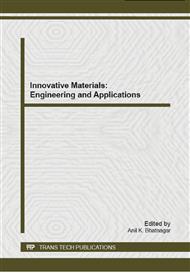[1]
N. J. Capiati, R.S. Porter: J. Materials Science. Vol. 10 (1975), p.1671.
Google Scholar
[2]
P.J. Hine, I.M. Ward, R.H. Olley, D.C. Basset: J. Materials Science. Vol. 28 (1993), p.316.
Google Scholar
[3]
M. Mosleh, N.P. Suh, J. Arinez: Composites Part A. Vol. 29 (1998), p.611.
Google Scholar
[4]
M.I. Maaty, D.C. Bassett, R.H. Olley, P.J. Hine, M. Ward: J. Mater. Sci. Vol. 31 (1996), p.1157.
Google Scholar
[5]
P.J. Hine, I.M. Ward, J. Teckoe: J. Materials Science. Vol. 33 (1998), p.4821.
Google Scholar
[6]
P.J. Hine, I.M. Ward: J. Applied Polymer Science. Vol. 91 (2004), p.2223.
Google Scholar
[7]
P.J. Hine,J. Hine, A. Astruc, I.M. Ward: J. Applied Polymer Science, 93 (2004), p.796.
Google Scholar
[8]
R. Li, D. Yao: J. Applied Polymer Science. Vol. 107 (2008), p.2909.
Google Scholar
[9]
P.J. Hine, I.M. Ward: J. Applied Polymer Science. Vol. 102 (2006), p.991.
Google Scholar
[10]
D. Bhattacharyya, P. Maitrot, S. Fakirov: Express Polymer Letters. Vol. 3 (2009), p.525.
Google Scholar
[11]
M. Duhovic, P. Maitrot, S. Fakirov: The Open Macromolecules Journal, Vol. 3 (2009), p.37.
Google Scholar
[12]
D.D. Wright, E.P. Lautenschlager, J.L. Gilbert: J. Biom. Materials Research. Vol. 36(1997), p.441.
Google Scholar
[13]
D. Yao, R. Li, P. Nagarajan: Polymer Engineering Science. Vol. 46 (2006), p.1223.
Google Scholar
[14]
P. Dai, W. Zhang, Y. Pan, J. Chen*, Y. Wang, D. Yao*: Composites Part B. Vol. 42 (2011), p.1144.
Google Scholar
[15]
Z. Zhao, J. Chen*: Composites Part B. Vol. 42 (2011), p.1306.
Google Scholar
[16]
J. Wang, J. Chen, P. Dai: Composites Science and Technology. Vol. 91(2014), p.50.
Google Scholar
[17]
J. Wang, Q. Mao, J. Chen: J. Applied Polymer Science. Vol. 130 (2013), p.2176.
Google Scholar
[18]
J. Rasburn, P.J. Hine, I.M. Ward, R.H. Olley: J Materials Science. Vol. 30 (1995), p.615.
Google Scholar
[19]
I.M. Ward, P.J. Hine: Polymer. Vol. 45(2004), p.1413.
Google Scholar
[20]
P.J. Hine, I.M. Ward, N.D. Jordan, R.H. Olley, D.C. Bassett: Polymer. Vol. 44(2003), p.1117.
Google Scholar
[21]
N.O. Cabrera, B. Alcock, T. Peijs: Composites Part B. Vol. 39 (2008), p.1183.
Google Scholar
[22]
Q. Mao, Y. Hongb, T.P. Wyattb, J. Chen, Y. Wang, J. Wang*, D. Yao*: submitted to Composites Science and Technology ( 2014).
Google Scholar


